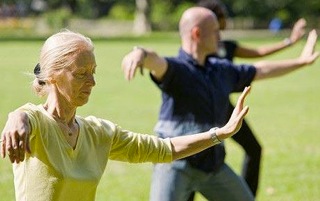Simple Tai Chi for Senior Skiers.
[Editor Note: SeniorsSkiing.com welcomes Tommy Kirchhoff, a long-time ski instructor and a certified Tai Chi master. He has been teaching senior exercises for 12 years. Tai Chi is an ancient martial art that has evolved to slow-moving poses that is practiced all over the world.]

I learned something valuable recently: my health and my body are one in the same.
I have been a professional skier for almost 30 years and have skied more deep powder days than most people can imagine. By senior year at university, I had skied over 10,000 hours. By the end of last year, I must have skied 35,000 hours or more. But this winter I’ve only skied about 20 days.
Not because I didn’t want to. I wasn’t injured or sick, and there was no impediment other than my will to stay healthy. I know that skiing can be rough on the body. For me, the day after skiing comes with aches and stiffness. Then it takes several days to repair the damage and return to a higher state of health. But I can always fix it.
Maybe it was Christmas. My two sons came to visit, and we skied six or seven days straight. I put them on a plane back home, and I fell ill—sudden sinus infection, a backache that screamed for the chiropractor, and overall lethargy.
And so began the repair.
Tai Chi is my body’s auto mechanic. I’ve been practicing it for almost 13 years. The gentle movements alleviate stiffness and bring order to physical chaos.
Here’s why:
- Gentle stretching—Tai Chi is full-body stretching, but nothing extreme. Being upright and on your feet allows all the joints to separate ever so softly and minutely.
- Continuous movement—When you see photos of Tai Chi it looks like static postures, similar to yoga; but continuous movement is a principle of Tai Chi, and a true mode of self-healing.
- Tongue position—Okay, this sounds strange, but when you press your tongue up into your hard palate, the body’s reaction is to relax. Less stress means more health.
- Deep breathing—Your body craves oxygen, and the slow, controlled, and deep breathing of Tai Chi feeds your cells ample oxygen for reparation.
If you want to experience the healing magic of Tai Chi without any classes or experience, go online to investigate ChiGong (often spelled QiGong, but pronounced “chee-gong”). ChiGong is the mother of Tai Chi. It is more like simple, repetitive calisthenics than the choreographed dance of Tai Chi, but it includes all the same healing principles.











